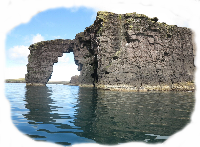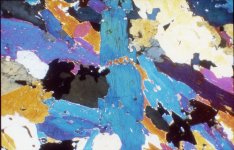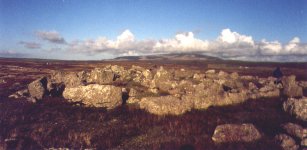

Geologically this is a very interesting place.
Eshaness has volcanic cliffs with andesitic and basaltic lavas, on the beaches good sized bits of agate and amethyst are found, especially after rough seas.
A definite line across from Braewick to Ronas Voe marks the start of the red granite cliffs and pinkish sands. At West Ayre the sand is pristine white with a high shell content. On the Aest Ayre, a shingle beach was man made over the years with the ballast from ships. Now an interesting mix of smooth pebbles from various countries including some flintstone and other types of rock is worth a look.
Then onto Hillswick Ness where there is serpentine, crystals of actinolite, garnet, kyanite, anthophyilite, hornblendic gneiss with a pink quartz-felsite and talc as well as several other minerals, making Hillswick Ness famous for having the greatest variety of metamorphic minerals in such a small area.

A steatite quarry is thought to have been used on Hillswick Ness in Viking times Steatite is also known as soapstone, in Shetland its kleber or clebber and the Norse name for steatite was kleberg. The talc content in steatite makes it easy to work with and decorative items were carved from it, but local folk being more practical in the nineteenth century, found it perfect when used for fire bricks, as well as making sinkers and spindle whorls from it.
Among some of the things made with the serpentine, was mace heads. They were cylinder shaped and tapered with hafting holes bored through them and are believed to be predated by axes. A mace head found at Hillswick can be seen at the Shetland Museum.
The 'Three Ages' system devised in Denmark can't be used accurately in Shetland and it has not been here, as the intention is only to mention some of the archaeological sites that are in this area and give a rough idea of what era they are from. Many crofters and walkers will soon realise that sites they know to exist are not mentioned here, this is because some sites are as yet 'undiscovered' and so are unrecorded. It is encouraging that Shetland Amenity Trust are at present gathering archaeological data from all over the islands and this areas old rocks will be included.
The earliest archaeological ruins in the HEARD area probably date from the Neolithic period and would include Grevasand House, on Hillswick Ness and the Black Water House in Eshaness, both were oval in shape and had low walls built from stone and turf roofs. To gain more height inside the floors were dug out afterwards.
Bodies at this time were buried in cists or stone boxes and in chambered cairns. At Gateside in Hillswick there is a Heel Shaped chambered cairn, this shape of a cairn is unique to Shetland.
The Muckla Water cairn in Eshaness is also called the March Cairn, as seen on the right. This chambered cairn is almost square in shape and unusual in that entry seems to have been from the east rather than the north where the remains of a facade can be seen.
The remaining site is on Hillswick Ness but this cairn is thought to have had no burial chamber.
